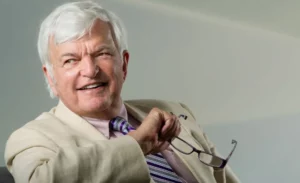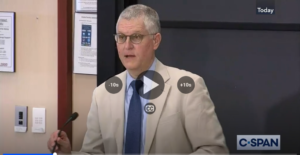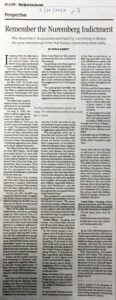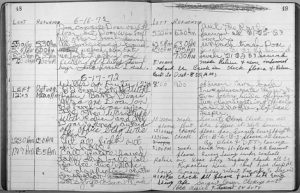My friend Dr. Douglas C. Neckers, Ph.D., was an organic chemist. He was a Professor of Chemistry and founder of the Center for Photochemical Sciences at Bowling Green State University. We met about twenty years ago through the Robert H. Jackson Center in Jamestown, New York, where we both came to serve on the board and Doug served for a number of years, powerfully and effectively, as board chair.
Doug was dazzlingly smart, intellectually voracious, and a constant teacher and communicator, including in writing. In his last years, he published many op-ed pieces and wrote on a blog he named “Science in 3D” — 3D printing was one of the fields in which he made a significant mark. The blog site is here.
A year ago, Doug, then a new widower after sixty years of a very happy marriage, wrote this essay about Thanksgiving. He wrote it too close to the 2021 Thanksgiving holiday to get it published in a newspaper. And for some reason he did not post it on his blog. Instead, he emailed it to me and I’m also sure to other friends — he liked, as he put it, the “excuse to send it individually”.
It is a beautiful essay. It’s about appreciating what we have, beginning with our loved ones, and about experiencing the sadnesses of people departing.
It turns out that this was Doug’s reflection on his final Thanksgiving. He died three days ago, on November 22, 2022, of cardiac arrest after battling COVID, which he acquired on a trip to Europe this summer.
Dr. Doug Neckers was a family man, scientist, author, teacher, mentor, and dear friend. He leaves legions of us as his survivors, so sad and so grateful.
*****
Thanksgiving, Then and Now
By Douglas C. Neckers
The British news magazine The Economist summed things up neatly when it was first published in 1843. Mankind, it said, was facing “a severe contest between intelligence, which presses forward, and an unworthy, timid ignorance obstructing our progress.”
You might read that and say, “The more things change, the more things stay the same. I come from a small town in the southwestern corner off New York which also produced the publisher, Horace Greeley, a man who shaped much of the course of modern journalism, including comprehensive coverage of an issue and emphasis on entertainment. He is best known for crusading for women’s rights and against slavery in his newspaper, the New York Tribune in 1841.
That, and saying “Go west, young man, go west.” Well, even though he died long before I was born. I took that advice, and now live in Ohio.
And, now that Thanksgiving 2021 is upon us, I realize more and more how thankful I am for those who saw the value of communication nearly two centuries ago, before radio and television, not to mention the internet.
Thanksgiving has changed too. In fact, I’m incredulous over how much has changed over the course of my lifetime when it comes to celebrating this uniquely American holiday. When I was a boy in the 1940s and 50s, Thanksgiving was a day to celebrate my paternal grandmother’s family, the sons and daughters of two immigrant families that came to western New York in the mid-19th century.
They came to escape starvation via a grueling eight-week ocean trip from Rotterdam to New York, then up the Hudson to Albany, the Erie Canal to Buffalo.
Then, they boarded a Great Lakes steamer as far as they dared take it on Lake Erie, and over land to the very western corner of New York State: Chautauqua County. No doubt about it: my ancestors were brave.
By the time I reached boyhood in the late 1940’s, most of our Civil War veterans had passed away, including my paternal great-grandfather. But many of the adults I grew up with knew about war, all right. There were World War I vets who knew about and had experienced toxic chlorine and mustard gas attacks in the trenches, though they never talked about them. There were World War II vets freshly back from some of the same battlefields their fathers had fought on in Europe, as well as many new ones there and in the South Pacific.
Those veterans were the young heroes of my day — bright, optimistic and ready for what the rest of their lives would bring them.
There were farmers in my orbit too, many of whom went deer hunting — some together, others alone, on the Thanksgiving mornings of my childhood.
These were hard-working, strong men who were able to spend hours in barns milking cows and servicing their stalls, and then go hunting, come back, sit and eat, and rest for the one day a year when they let themselves do that.
Venison was still a staple in winter in Chautauqua County then, and most every farm family had its share of deer meat. But on Thanksgiving, the women cooked turkey with all the fixings and lots of various fruit pies for dessert. This was, after all, an area where Concord grapes, peaches and apples literally fell off trees and vines in August and September.
But the lives of my ancestors hadn’t always been so abundant. Little did I, as a small boy in the 1940s, know how hard it had been and how hard it sometimes still was for my families and, especially, for their ancestors. These heroes survived the hard winters in an area where winters were really hard. They heated small and not-so-small houses with wood stoves, walked outside on cold mornings to the outhouses near the barnyard of every farm, and eked out a subsistence living from rocky, hilly soil, land better suited to a ski resort than for growing wheat or corn.
Nevertheless, no matter how tough it got, we knew it had been worse in the past for our ancestors, and everyone was thankful for what they had.
Fast forward a few decades to the many years when I was a university professor. In other words, like so many of my generation, I was one of the group of able young people who had chosen to leave the fields and farms of my hometown to pursue a different career — in my case, teaching and research.
To succeed, I had to develop my own research initiatives. On the farm, that might have meant experimenting with ways to get higher crop yields. In my labs, that meant inventions and discoveries that could lead to new businesses.
And this I did. I managed to discover the basic science that turned analog photography into digital, and from there, the basics for what became stereolithography and 3D printing, I pushed the envelope of what was possible in various areas, some of which form some of the basis of what different industries in my field use today. I helped bring America some brilliant scientific advances and saw many new businesses rise from the ground long after the farms in western New York sadly could no longer support even the simplest living styles.
But I still loved Thanksgiving, because it was the one day every year when no one did anything but stay home, be thankful, eat well and know that they were blessed by the bounty and goodness of a great country.
By now, of course, those many farmers from my childhood have long passed from the earth, leaving just memories. Things began to change, too, with the dads and mothers whose company we enjoyed for so many Thanksgivings.
Nature is, if not ruthless, unyielding. Parents became ill and our family, like many, was placed in a position of being caregivers. Holidays now could be spent caring for Mom or Dad or at least going to home to a very different place.
We were still thankful, even if turkey sometimes wasn’t on the table, for we were together. Then, one day, we weren’t.
Our parents’ entire generation was fading away. Last year, it started to become our turn, specifically, my turn. This year, it is my turn to go to Thanksgiving alone. My wife Suzanne and I spent decades years together, until she passed away this June, a day before our 61st wedding anniversary.
On our first thanksgiving in Lawrence, Kansas my uncle and aunt drove in from Southern Illinois to spend it with us. I know Suzanne got lots of tips from my aunt, while I enjoyed my uncle’s company, even though he was then a distinguished professor of chemistry and I a mere graduate student.
Things come full circle. Now, I feel almost like an 18-year-old leaving home for the first time; I’m back in the swirling waters not so much of loneliness but emotional insecurity. The family members I gathered with in those farmhouses of Western New York to celebrate how better off we were than in the old country, are completely gone. There’s no one to celebrate with save my children and me.
Still, am I thankful? You bet. But I am sad, too. Don’t tell anyone, but I have never really liked pumpkin pie, but for just one more of those Thanksgiving days of yore, I’d cheerfully have a piece … maybe even two.








